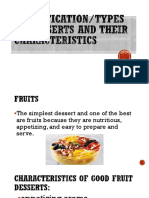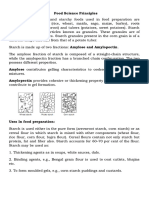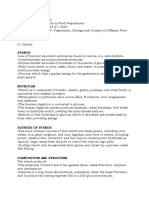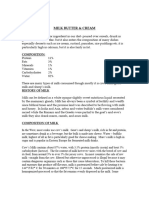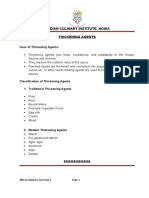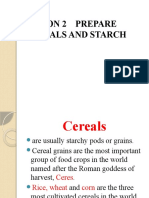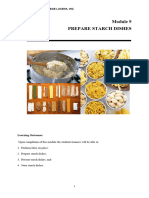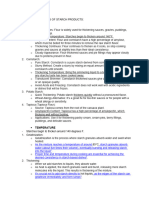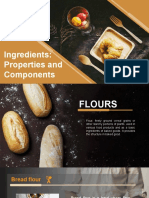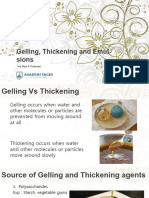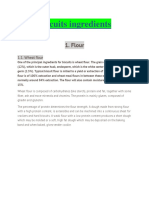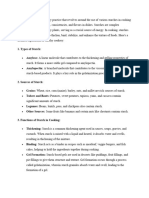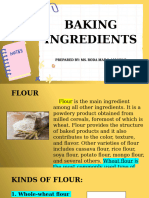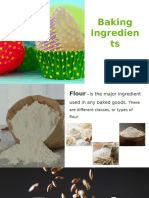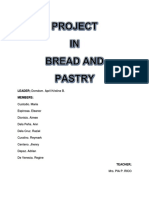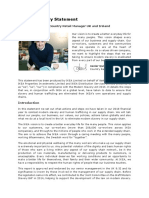0 ratings0% found this document useful (0 votes)
14 viewsEdtech
Edtech
Uploaded by
Patricia LaguadorStarches are the main form plants use to store energy and are found in seeds, tubers, and roots. Common starches include cornstarch, flour, and tapioca. Starches are used to thicken foods like sauces, soups, and puddings. To prevent lumping, starch is mixed with cold water before cooking. Cooking gelatinizes the starch granules to fully release their thickening power.
Copyright:
© All Rights Reserved
Available Formats
Download as PPTX, PDF, TXT or read online from Scribd
Edtech
Edtech
Uploaded by
Patricia Laguador0 ratings0% found this document useful (0 votes)
14 views24 pagesStarches are the main form plants use to store energy and are found in seeds, tubers, and roots. Common starches include cornstarch, flour, and tapioca. Starches are used to thicken foods like sauces, soups, and puddings. To prevent lumping, starch is mixed with cold water before cooking. Cooking gelatinizes the starch granules to fully release their thickening power.
Original Title
edtech
Copyright
© © All Rights Reserved
Available Formats
PPTX, PDF, TXT or read online from Scribd
Share this document
Did you find this document useful?
Is this content inappropriate?
Starches are the main form plants use to store energy and are found in seeds, tubers, and roots. Common starches include cornstarch, flour, and tapioca. Starches are used to thicken foods like sauces, soups, and puddings. To prevent lumping, starch is mixed with cold water before cooking. Cooking gelatinizes the starch granules to fully release their thickening power.
Copyright:
© All Rights Reserved
Available Formats
Download as PPTX, PDF, TXT or read online from Scribd
Download as pptx, pdf, or txt
0 ratings0% found this document useful (0 votes)
14 views24 pagesEdtech
Edtech
Uploaded by
Patricia LaguadorStarches are the main form plants use to store energy and are found in seeds, tubers, and roots. Common starches include cornstarch, flour, and tapioca. Starches are used to thicken foods like sauces, soups, and puddings. To prevent lumping, starch is mixed with cold water before cooking. Cooking gelatinizes the starch granules to fully release their thickening power.
Copyright:
© All Rights Reserved
Available Formats
Download as PPTX, PDF, TXT or read online from Scribd
Download as pptx, pdf, or txt
You are on page 1of 24
Starches
Starch is the main form
in which plants
conserve their energy;
it is found in greater
amounts in seed,
tubers, and root
vegetables than in
other type of
vegetables, but some
starch is food in all
vegetable tissue.
The number of glucose molecules
ranges from 40 to several hundred
thousand, as the size of molecule
increase, its solubility decreases.
Most starches are mixtures of
approximately three-fourths amylose
and one-fourth amylopectin.
Amylose is a linear
polysaccharide that is linked
together by a-1, 4 linkages.
Amylopectin is a branched- chained
polysaccharide that has a-1, 6 linkages every
20- 30 glucose units in addition to the linear a-
1, 4 linkages.
Properties of
Starches
Changes During Coo
king of Starch
Any Starch is more digestible
cooked than raw. During the
cooking of starch mixtures, several
important changes take place that
are significant in the preparation of
typical starch products.
Principle of Cooking
Starches
When starch is cooked, the goal is to
obtain the full value of its thickening
power. This can be accomplished only
when there is sufficient heat and water
to hydrate the starch granule. Heating
the starch mixture above the
gelatinization temperature results in
the continued swelling of the granule.
Lumping
When dry starch is mixed with warm or hot
water, the exterior portion of the starch
granules becomes sticky and the granules
cling together in lumps. Heating does not help
to separate the granules; formed, the lumps
tend to remain intact. If one of these lumps is
broken open, raw starch is found inside. Lump
formation may be prevented in three ways.
Effect of Sugar and A
cids
Sugar has a tenderizing effect on a
starch gel. If it is not used in extreme
amounts, it will also protect the swollen
starch grains from rupturing from
mechanical damage such as stirring. When
acids are cooked with a starch mixture,
they have the effect of decreasing the
thickening power of starch.
Effect of Dry Heat
Dry heat also brings changes to
starch granules through a process
known as dextrinization. If starch or a
product containing starch is subjected
to dry heat, carbohydrate compounds
called dextrins are formed.
Retrogradation
After a starch gel has cooled or
chilled, the starch becomes less soluble
and recrystallizes. This is known as
retrogradation of starch. It is more likely
to occur in starches with a high
proportion of amylose. Amylopectin
does not gel when cooled.
Retrogradation of a starch
gel is greatly accelerated by
freezing. When a starch gel is
thawed, water is lost because
it is unable to rebind to the
fragile spongy mass.
Modified Starches
A modified starch has been treated
with chemicals, resulting in starches that
have suitable properties for use in the
food industry. Acids used to treat starches
bring about granule disintegration and a
corresponding lowered viscosity;
however, the gel that is formed is rigid.
hi te
W
Sa u c e
Cream METHODS
Soup OF
Gravies PREPARING
STARH
Puddings DISHES
White
Sauce
White sauce is the basis for many
frequently prepared foods such as cream
sauces, soufflés, croquettes, and scalloped
dishes. White sauce is a mixture of flour
and milk, with some fat added for flavour.
A white sauce is thick, with a smooth
satiny appearance free of lumps. The taste
is pleasant and without any suggestion of
uncooked starch.
Gravies
Gravies are prepared in a similar manner
to a medium white sauce. The starch is
separated by coating with meat fat or by
suspending it in cold water to make a slurry.
Gravy is different from white sauce in using
meat drippings(which may be diluted with
hot water) as liquid rather than milk. A dark
brown colour can be achieved by the
addition of a commercial gravy colour
additive.
Cream
Soup
Cream soups are thin white sauces
to which vegetable juices, vegetable
puree, or pieces of meat, poultry, or
fish are added. Freshly prepared,
canned, frozen, or leftover foods may
be used to prepare a great variety of
these highly nutritious and palatable
soups.
Puddings
Milk or fruit juices thickened
with a starchy material forms the
main ingredients in a number of
very popular desserts. Corn
starch, rice, tapioca, cornmeal and
sago are frequently used for this
purpose.
Cornstarch pudding
In making a cornstarch
pudding, as in making a white
sauce, it is necessary to
separate the granules of starch
before they are added to the
liquid.
Tapioca
Tapioca, like cornstarch and flour, is a
band in flavour and is usually combined
with other materials for variety and
interest. In the manufacture of tapioca, the
tuberous roots maniac (cassava) are
ground and the starch is removed from the
fiber and dried. In the preparation of this
product, some of t he starch granules are
ruptured when heated, partly cooking the
product. Tapioca can be purchased in pearl
and granule forms.
Other Puddings
One of the most famous of all
thickened milk puddings is rice
pudding, which is a mixture of one
part of rice to about eight parts milk.
To these ingredients, sugar,
flavouring, raisins, and occasionally
eggs are added. The mixture may be
baked in the oven for several hours
(the preferred method) or cooked in
the top of a double boiler until thick.
Summary
Various starches are used in food preparation,
including cornstrach, rice starch, wheat starch (flour),
tapioca starch, potato starch, and sago starch.
Because of their thickening power, they are used in
soups, sauces, puddings and other foods. To avoid
lumping, dry starch is usually first mixed with cold
water to form a paste. Sufficient heat and moisture
then secure the maximum thickening of the starch.
Sugar and acids tenderize a starch gel. Methods of
preparing of the other ingredients.
Thank You for
Listening
You might also like
- Alan Downs - The Velvet Rage - Overcoming The Pain of Growing Up in A Straight Man's WorldDocument259 pagesAlan Downs - The Velvet Rage - Overcoming The Pain of Growing Up in A Straight Man's Worldstatisticka analiza100% (3)
- Identifying The Ingredients in BakingDocument5 pagesIdentifying The Ingredients in Bakingjoice dela cruzNo ratings yet
- Classification of DessertsDocument42 pagesClassification of DessertsJoey Albania Aguinaldo75% (8)
- Baking Ingredients and Their FunctionsDocument5 pagesBaking Ingredients and Their FunctionsZie BeaNo ratings yet
- Employment Contract - Part Time Salaried EmployeesDocument9 pagesEmployment Contract - Part Time Salaried EmployeesMhai Mhai Menez DueNo ratings yet
- Syneration and Retrogradation Outline and WRDocument5 pagesSyneration and Retrogradation Outline and WRJaime Añora ParedesNo ratings yet
- Starch ND Cereal DishesDocument64 pagesStarch ND Cereal Dishesjustinerafa6No ratings yet
- 4 Food Science PrinciplesDocument6 pages4 Food Science Principlesavantip388No ratings yet
- BAKING-Refers To Cooking by Dry Heat Especially in An Oven Where TemperatureDocument13 pagesBAKING-Refers To Cooking by Dry Heat Especially in An Oven Where TemperatureShallimar AlcarionNo ratings yet
- Information Sheet No.3Document8 pagesInformation Sheet No.3Edlyn ArandiaNo ratings yet
- Time For ReflectionDocument1 pageTime For Reflectionabby_grasta3267No ratings yet
- Milk and Milk ProductsDocument35 pagesMilk and Milk ProductsAnamaeNo ratings yet
- 1481 Milk Butter CreamDocument6 pages1481 Milk Butter CreamKrishna KumarNo ratings yet
- Indian Culinary Institute, Noida Thickening AgentsDocument4 pagesIndian Culinary Institute, Noida Thickening AgentsAnupam AlokNo ratings yet
- Lesson 2 Prepare Cereals and StarchDocument69 pagesLesson 2 Prepare Cereals and Starchgracemelody.velasco.xNo ratings yet
- Carbohydrates 2Document27 pagesCarbohydrates 2Vanshik BhattacharyaNo ratings yet
- Chemical and Functional S1-1Document26 pagesChemical and Functional S1-1HamidNo ratings yet
- Lesson 2 Prepare Cereals and StarchDocument59 pagesLesson 2 Prepare Cereals and StarchMarry Jane Lustre CanabalNo ratings yet
- Unit 1Document15 pagesUnit 1Praghnya C.LNo ratings yet
- Lec 7 YogurtDocument4 pagesLec 7 YogurtTarequl Islam NishadNo ratings yet
- Bakeshop IngredientsDocument12 pagesBakeshop IngredientsJulia Mae TagabNo ratings yet
- OOD Echnology: Technology in Food ProductionDocument30 pagesOOD Echnology: Technology in Food ProductionlelascepanovicNo ratings yet
- Ingredients of Ice CreamDocument37 pagesIngredients of Ice CreamRao Qaisar Shahzad100% (1)
- Module 9 Prepare Starch DishesDocument9 pagesModule 9 Prepare Starch DishesGilbert LoredoNo ratings yet
- Flours and Flour MixturesDocument55 pagesFlours and Flour MixturesMaydell Alberto DanacNo ratings yet
- DESSERTS Level 4 NotesDocument7 pagesDESSERTS Level 4 Notessundys100% (3)
- Topic 2 (Raw Materials 1)Document8 pagesTopic 2 (Raw Materials 1)babu197No ratings yet
- Bread TipsDocument7 pagesBread TipsjpcmansoNo ratings yet
- Lesson 9 - Prepare Starch DishesDocument49 pagesLesson 9 - Prepare Starch DishesJoshua LaxaNo ratings yet
- Chapter 5 Baking IngredientsDocument39 pagesChapter 5 Baking IngredientsLatada, Christian MichaelCvSUNo ratings yet
- Basic Baking Ingredients: Baking Powder and Baking SodaDocument4 pagesBasic Baking Ingredients: Baking Powder and Baking SodaAyla DavaNo ratings yet
- Baking PrinciplesDocument58 pagesBaking PrinciplesJeane De Jesus NacpilNo ratings yet
- GIFT Food Assign 2Document8 pagesGIFT Food Assign 2CathrineNo ratings yet
- Classification and Characteristics of FlourDocument10 pagesClassification and Characteristics of FlourCamille AlberichNo ratings yet
- SaucesDocument83 pagesSaucesYiannis PogasNo ratings yet
- Modern Pastry and Plated Dessert Techniques 1446156001Document54 pagesModern Pastry and Plated Dessert Techniques 1446156001gabyculinar0% (1)
- Proper Cooking of Starch ProductsDocument7 pagesProper Cooking of Starch ProductsGarcia, Steven S.No ratings yet
- Starch PowderDocument4 pagesStarch Powdernakul21042000No ratings yet
- Properties and Components of Basic Baking PresentationDocument40 pagesProperties and Components of Basic Baking PresentationKhalid P. BataraNo ratings yet
- Starch and Alimentary PasteDocument6 pagesStarch and Alimentary PasteAbbygale Therese LunaNo ratings yet
- Ottage Cheese, Quark, Fromage Frais, and Cream CheeseDocument4 pagesOttage Cheese, Quark, Fromage Frais, and Cream CheeseDanniella HenryNo ratings yet
- INFODocument8 pagesINFOann acederaNo ratings yet
- Dairy ProductsDocument15 pagesDairy ProductsDoumbia MohamedNo ratings yet
- Flour, Sugar and CerealsDocument3 pagesFlour, Sugar and Cerealsbona bless labadanNo ratings yet
- Texture - Thickening, Emulsions, FoamDocument58 pagesTexture - Thickening, Emulsions, Foamrgkmq8chfpNo ratings yet
- SaucesDocument83 pagesSaucesYateen Gharat100% (3)
- Biscuit R.M 1Document5 pagesBiscuit R.M 1Mahmoud TahaNo ratings yet
- StarchDocument42 pagesStarchsachinshinde_texNo ratings yet
- CVN BPP PPTDocument77 pagesCVN BPP PPTalipogpog024No ratings yet
- Starchy CookeryDocument7 pagesStarchy CookeryPreet RayatNo ratings yet
- Wikarambulan!Document46 pagesWikarambulan!Donna D. GuzmaniNo ratings yet
- Bread and Pastry Lesson 3 Baking IngredientsDocument26 pagesBread and Pastry Lesson 3 Baking IngredientsRoda Mae AmamagNo ratings yet
- Foodworks-International: Baking Ingredients and Their FunctionsDocument5 pagesFoodworks-International: Baking Ingredients and Their FunctionsXtian PedroNo ratings yet
- Prepare Starch and CerealsDocument43 pagesPrepare Starch and CerealsJesusa Galoyo100% (1)
- Baking Ingredients 3Document38 pagesBaking Ingredients 3wnsgdmgcnfNo ratings yet
- Prepare DessertDocument43 pagesPrepare Dessertaizel roncejero50% (2)
- All IngridientsDocument29 pagesAll IngridientsAvril DomdomNo ratings yet
- Milky MistDocument18 pagesMilky Mistashmenon08No ratings yet
- Cheese Making A Step-By-Step Guide for Making Delicious Cheese At HomeFrom EverandCheese Making A Step-By-Step Guide for Making Delicious Cheese At HomeNo ratings yet
- FS 103 - L6Document31 pagesFS 103 - L6Ma. Isabel C. ChicoNo ratings yet
- Basic BakingDocument77 pagesBasic BakingClariss Quiambao VitugNo ratings yet
- Learning Outcome 2Document10 pagesLearning Outcome 2rectomickaelajoyNo ratings yet
- Conversion TablesDocument4 pagesConversion TablesChetan GadiaNo ratings yet
- Chirag Barad-EHSDocument4 pagesChirag Barad-EHSChirag BaradNo ratings yet
- SOP For Steam Penitration Study by Bowie-Dick Test - PharmaguidelineDocument2 pagesSOP For Steam Penitration Study by Bowie-Dick Test - PharmaguidelineSayan BharNo ratings yet
- Verdict Caliper Gauges Internal and External Dial Caliper GaugesDocument13 pagesVerdict Caliper Gauges Internal and External Dial Caliper GaugesArchana RachelNo ratings yet
- Thesis Paper Marketing Strategies of A PDocument66 pagesThesis Paper Marketing Strategies of A Pnelahammad182No ratings yet
- Milma Diary FinalDocument66 pagesMilma Diary FinalClick Pick100% (2)
- Module 1 Forensic 3 October 2021Document11 pagesModule 1 Forensic 3 October 2021Narciso Ana JenecelNo ratings yet
- Ikea Modern Slavery Statement PDFDocument11 pagesIkea Modern Slavery Statement PDFXhevat ZiberiNo ratings yet
- Outdoor EnclosuresDocument15 pagesOutdoor EnclosuresGolden Epafras TrengcleNo ratings yet
- Faraday Communications From Bulk Ceo, To Supported Cerium-Oxygen Clusters: A Diffuse Reflectance ApproachDocument2 pagesFaraday Communications From Bulk Ceo, To Supported Cerium-Oxygen Clusters: A Diffuse Reflectance ApproachAngel FajmNo ratings yet
- ESET - Download - For Business - Detail - ESET Remote Administrator 6 All-In-One InstallersDocument3 pagesESET - Download - For Business - Detail - ESET Remote Administrator 6 All-In-One Installersgeorge_adi_2200No ratings yet
- A Case Report of Ureteric Calculus Treated With Homoeopathic Medicine, Hydrangea Arborescens 30Document7 pagesA Case Report of Ureteric Calculus Treated With Homoeopathic Medicine, Hydrangea Arborescens 30Baru Chandrasekhar RaoNo ratings yet
- City Centre Rohini ThesisDocument6 pagesCity Centre Rohini ThesisCustomPapersWritingSpringfield100% (2)
- SES Reading Intervention Program For Grade Three Non-ReadersDocument3 pagesSES Reading Intervention Program For Grade Three Non-ReadersMichael Edward De VillaNo ratings yet
- Experimental Report 20170607 1Document12 pagesExperimental Report 20170607 1JR GinussNo ratings yet
- Certificate of Insurance Template: Policy InformationDocument5 pagesCertificate of Insurance Template: Policy Informationvarshini042No ratings yet
- List of Fabrics - WikipediaDocument22 pagesList of Fabrics - WikipediaAr ThakurNo ratings yet
- (U) Daily Activity Report: Marshall DistrictDocument6 pages(U) Daily Activity Report: Marshall DistrictFauquier NowNo ratings yet
- Composite InformationDocument2 pagesComposite InformationKris Aileen CortezNo ratings yet
- Safety, Analgesic, and Anti-Inflammatory Effects of Aqueous and Methanolic Leaf Extracts of Hypericum Revolutum Subsp. KenienseDocument11 pagesSafety, Analgesic, and Anti-Inflammatory Effects of Aqueous and Methanolic Leaf Extracts of Hypericum Revolutum Subsp. KenienseInternational Journal of Innovative Science and Research TechnologyNo ratings yet
- F-SM6R-DM1A-A22-L1: Product DatasheetDocument2 pagesF-SM6R-DM1A-A22-L1: Product DatasheetEzraKitrieGunawanNo ratings yet
- 1996 - Nesbitt Et Al - Applications of Oxygen and Hydrogen Isotopes To Exploration For Hydrothermal MineralizationDocument7 pages1996 - Nesbitt Et Al - Applications of Oxygen and Hydrogen Isotopes To Exploration For Hydrothermal MineralizationtoledopolianaNo ratings yet
- Struktur Komunitas Ikan KarangDocument14 pagesStruktur Komunitas Ikan KarangMohamad Saeful HidayatNo ratings yet
- Constantino v. Asia Life 2Document5 pagesConstantino v. Asia Life 2Randy SiosonNo ratings yet
- 18-Arid-879 Final Term Examination MGT-515, Human Resource Management, Syeda Tashifa Batool, BBA4th (B)Document11 pages18-Arid-879 Final Term Examination MGT-515, Human Resource Management, Syeda Tashifa Batool, BBA4th (B)Syed Muhammed Sabeehul Rehman100% (1)
- BestPractices in Water ManagementDocument78 pagesBestPractices in Water Managementverrapa100% (1)
- Blaser 2015Document12 pagesBlaser 2015giant nitaNo ratings yet
- Denture Remounting Selective Grinding DR OsamaDocument11 pagesDenture Remounting Selective Grinding DR OsamaReber ZebariNo ratings yet


